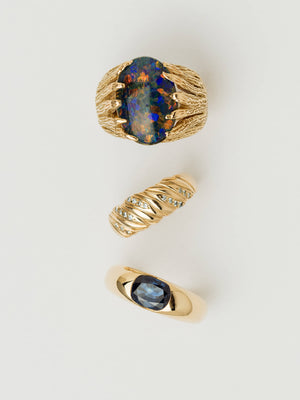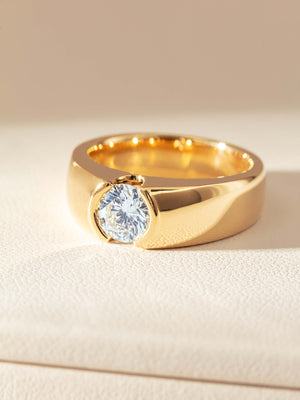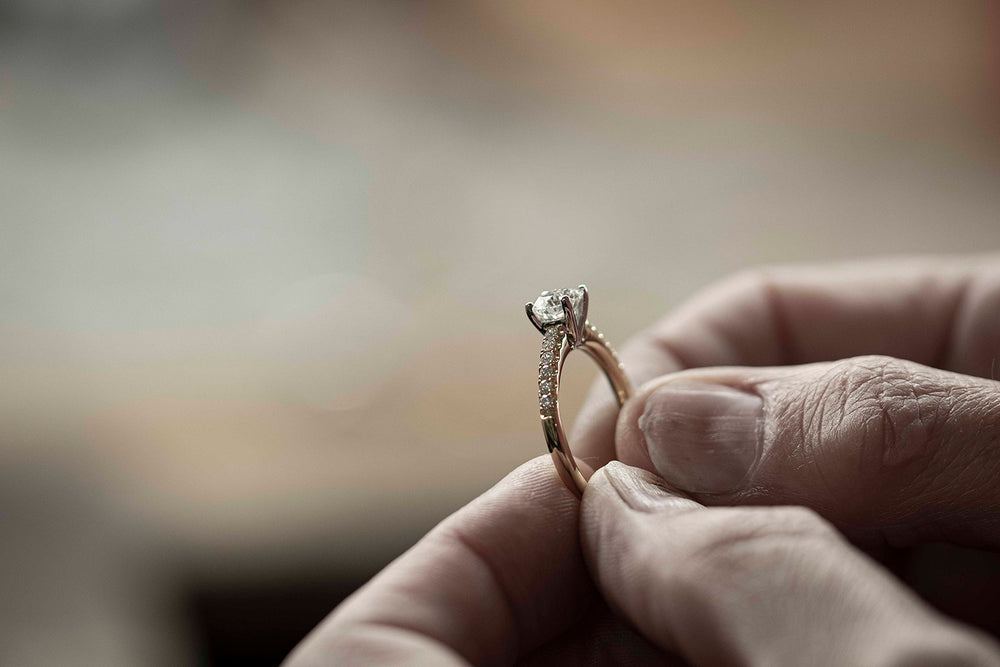Natural diamonds have existed since before life on earth. Finite in number, natural diamonds form when carbon is exposed to intense heat and pressure deep within the earth; most were created between 1-3 billion years ago. Technology now enables the production of chemically identical gems in just a few weeks. Marketed as artificial, lab-grown, created, cultured, or synthetic, factory-produced diamonds are now available in gem quality and are becoming a part of the fascinating diamond story.
Lab diamonds have gained popularity for their ethical production and affordability. While they offer many benefits, including cost-effectiveness and reduced environmental impact, questions linger about lab diamond value and sustainability.
Join us as we explore how lab diamonds are made and why they may not be the future of jewellery. We'll look at the complex dynamics surrounding lab-grown diamonds and why reclaimed diamonds may be a preferable alternative in the world of fine jewellery.
How Are Lab Diamonds Made?
Lab-grown diamonds are created by replicating the natural conditions under which diamonds form deep within the earth. High-Pressure High-Temperature (HPHT) and Chemical Vapor Deposition (CVD) are the primary methods for producing lab-grown diamonds.In the HPHT method, carbon source material, typically a diamond seed, is exposed to high pressure and temperatures to encourage crystal growth. In the CVD method, a carbon-rich gas is introduced into a vacuum chamber, where it undergoes chemical reactions to deposit carbon atoms onto a diamond substrate, layer by layer, forming a crystal.
Lab Diamonds in the Market
While lab diamonds have been around since the 1950s, they have only recently been commercially produced at a gem quality suitable for jewellery. The rising popularity of lab-grown gems when we shop for diamond rings and other types of jewellery poses many interesting questions for the jewellery industry and their potential impact on the future of the diamond market.
Initially, the cost of a lab diamond was approximately 20% cheaper than a natural diamond. However, as technology has improved and supply has increased, that cost has reduced considerably. In 2015, Brilliant Earth, a US online diamond retailer, was selling a 2ct lab diamond for $22,000. In January 2019, a lab diamond of the same size and grade was selling for $6,800, and in October 2019, you could find a lab diamond with similar grading for $4,000. Fast-forward to 2023, and you can find a 2ct lab diamond for $2,170—approximately 80% cheaper than a natural diamond with similar characteristics.
We can draw interesting comparisons from the coloured gemstone market, where synthetic ruby, sapphire, and emerald have been available for decades. Initial demand created widespread production; the following oversupply led to value erosion, with lab-grown gems now worth only a few dollars. In contrast, the natural market for coloured gems has never been stronger, with significant price increases owing to the finite supply of natural gems.
An Illusion of Sustainability
Most factory-produced diamond suppliers provide marketing to support the idea that their product is eco-friendly. Some state that their stones have up to 98% less carbon emissions produced. This statement is based on research from companies that diamond suppliers have employed to further their business growth.
Likewise, available studies support the alternate view that lab diamonds produce 3x more carbon emissions than an equivalent-sized natural stone. These emissions come from the immense amount of water and energy required to heat and cool the industrial microwaves. In essence, both sides can provide statistics that support their theory, and it would be sensible to consider each in this light.
Challenges Identifying the Genuine Origin of Lab Diamonds
Another pressing issue that the increased supply of synthetic diamonds raises is whether the genuine origin of the diamond is represented accurately. Even highly skilled gemmologists cannot distinguish the difference by sight alone.
Identification of lab-produced diamonds requires expert technology, such as the id300 by GIA, which can identify lab diamonds with 100% accuracy. It is more important than ever to choose a company you can trust that has invested in the technology and training to ensure integrity in what they are selling.
With more suppliers entering the market, the supply of lab diamonds will surely continue to grow. The degree to which consumer demand will absorb this additional supply and its effect on pricing remains to be seen. As always, the paramount consideration should be that buyers can trust who they are buying from and that suppliers can provide accurate representations about any presented options.
The Value of Lab Diamonds
Lab-grown diamonds may not hold their value like natural diamonds, primarily due to market perception and rarity. Natural diamonds have established a reputation for rarity, symbolising timelessness and exclusivity. Their geological formation over millions of years deep within the earth adds to their allure, creating a sense of intrinsic value.
In contrast, lab diamonds, while often identical in physical properties, lack this natural origin story. As they become more prevalent and easier to produce, the market may perceive them as less unique, making them less likely to appreciate over time.
The relatively recent emergence of lab diamonds means there is limited historical data on their resale value, contributing to uncertainties about their long-term investment potential. These factors, alongside preferences and the emotional and symbolic value associated with natural diamonds, may impact the way lab diamonds hold their value in the jewellery market.
The Future of Diamonds
Currently, lab diamonds may not be the future of diamonds. But what about those looking for a more sustainable diamond that still holds its value? Enter reclaimed diamonds.
Reclaimed diamonds, also known as recycled or second-hand, have been previously owned and are being repurposed for resale in the jewellery market. These diamonds are sourced from various origins, including pre-owned jewellery, estate sales, or diamond dealers, and are carefully inspected, cleaned, and sometimes recut to re-enter the market.
Reclaimed diamonds offer a sustainable and ethical alternative to lab-grown diamonds. They eliminate the need for new diamond mining, reducing the environmental impact and ethical concerns associated with traditional diamond extraction. Additionally, reclaimed diamonds often possess unique histories and characteristics, making them a compelling choice for those who appreciate the individuality and timeless appeal of vintage and antique jewellery.
Explore the stunning allure of Walker & Hall’s natural diamonds today.











